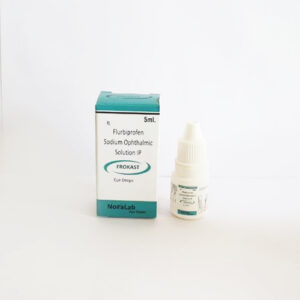- Home
- EYE /EAR & NASAL DROPS
- Gatifloxacin & Betamethsone Opthalmic Solution


Gatifloxacin & Betamethsone Opthalmic Solution
GATYKAST-B
Enquiry about Gatifloxacin & Betamethsone Opthalmic Solution

Gatifloxacin & Betamethasone Ophthalmic Solution is a medication for eye conditions. Gatifloxacin, a broad-spectrum antibiotic, fights bacterial infections in the eye, while Betamethasone, a corticosteroid, reduces inflammation. This combination is effective in treating bacterial eye infections with an inflammatory component, such as conjunctivitis. Administered as eye drops, it provides targeted relief by addressing both infection and inflammation. Proper dosage adherence and consultation with healthcare professionals are crucial. This ophthalmic solution plays a vital role in managing ocular conditions, promoting healing, and alleviating symptoms associated with bacterial eye infections and inflammation.
Benefits of Using Gatifloxacin & Betamethsone Opthalmic Solution
Gatifloxacin & Betamethasone Ophthalmic Solution offers dual benefits in eye care. Gatifloxacin, an antibiotic, effectively combats bacterial eye infections, while Betamethasone, a corticosteroid, concurrently alleviates inflammation. This combination is particularly beneficial in treating conditions like conjunctivitis, where infection and inflammation coexist. Administered as eye drops, the solution provides targeted relief, promoting faster healing and symptomatic relief. By addressing both aspects of ocular issues, it offers a comprehensive approach to eye health. Properly following prescribed dosages and consulting healthcare professionals ensure optimal benefits, making this ophthalmic solution a valuable tool in managing bacterial eye infections with an inflammatory component.
How to Use Gatifloxacin & Betamethsone Opthalmic Solution
To use Gatifloxacin & Betamethasone Ophthalmic Solution, wash hands thoroughly. Tilt the head back and pull down the lower eyelid, creating a pocket. Instill the prescribed number of drops into the eye, avoiding contact with the dropper tip. Close the eye gently and apply slight pressure to the inner corner for a minute to prevent drainage. Use as directed by healthcare professionals, typically several times daily. Complete the full course even if symptoms improve. Remove contact lenses before administration and wait at least 15 minutes before reinserting. Adhering to proper dosage and guidelines ensures effective treatment for bacterial eye infections with inflammation.
How Gatifloxacin & Betamethsone Opthalmic Solution
Gatifloxacin & Betamethasone Ophthalmic Solution is a combination medication for eye care. Gatifloxacin, an antibiotic, combats bacterial eye infections, while Betamethasone, a corticosteroid, reduces inflammation. Administered as eye drops, this solution is effective in treating ocular conditions where infection and inflammation coexist, such as conjunctivitis. It provides targeted relief, promoting faster healing and symptomatic relief. Following prescribed dosages and proper administration ensures comprehensive management of bacterial eye infections with an inflammatory component. Regular consultation with healthcare professionals is essential for optimal usage, promoting healing, and maintaining ocular health.
Precautions While Using Gatifloxacin & Betamethsone Opthalmic Solution
When using Gatifloxacin & Betamethasone Ophthalmic Solution, take precautions to minimize potential risks. Inform healthcare professionals about allergies or pre-existing eye conditions. Remove contact lenses before administration and wait 15 minutes before reinserting. Avoid touching the dropper tip to prevent contamination. Use cautiously in individuals with a history of steroid-related intraocular pressure elevation. Prolonged use might lead to cataract formation. Monitor for side effects such as eye discomfort or blurred vision. Regular eye check-ups are crucial to assess treatment efficacy and adjust the dosage if necessary. Adherence to the recommended dosage and administration guidelines is essential for optimal results.
Side Effects of Using Gatifloxacin & Betamethsone Opthalmic Solution
Gatifloxacin & Betamethasone Ophthalmic Solution might cause side effects such as temporary blurred vision, eye discomfort, or burning sensations. Prolonged use might elevate intraocular pressure, potentially leading to glaucoma or cataracts. In rare cases, individuals might experience hypersensitivity reactions or secondary fungal eye infections. Contact healthcare professionals if persistent irritation or adverse effects occur. Regular monitoring during treatment is crucial to assess side effects, and adjustments to the dosage or discontinuation might be necessary based on individual responses. It is essential to follow prescribed guidelines and promptly report any unusual symptoms, ensuring comprehensive management of ocular health.



